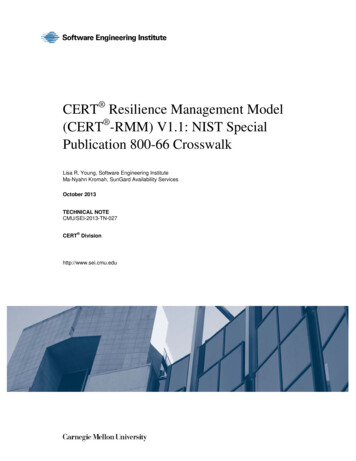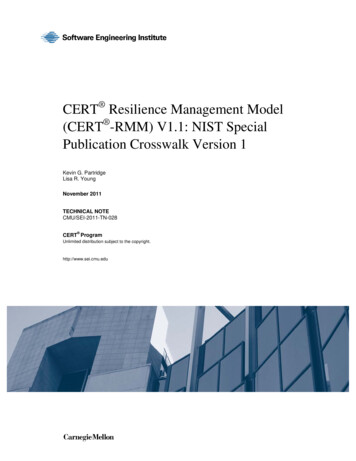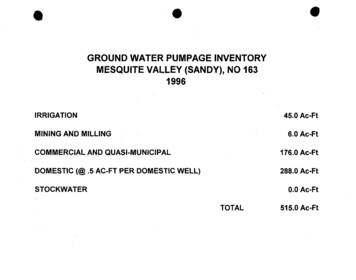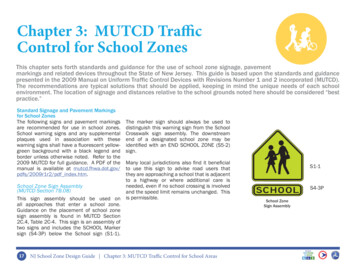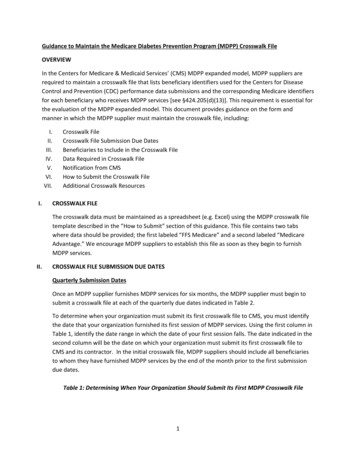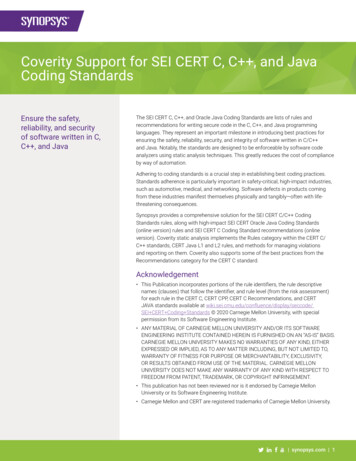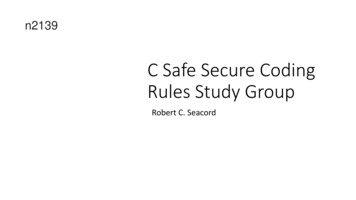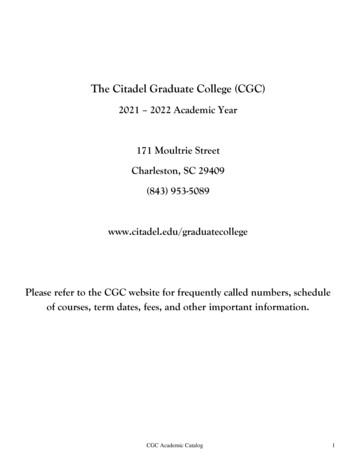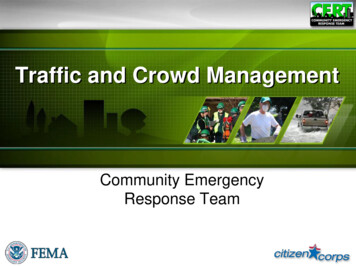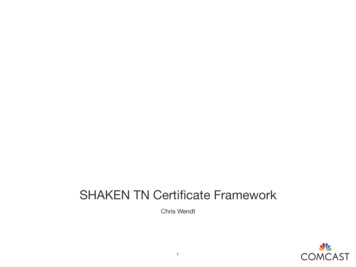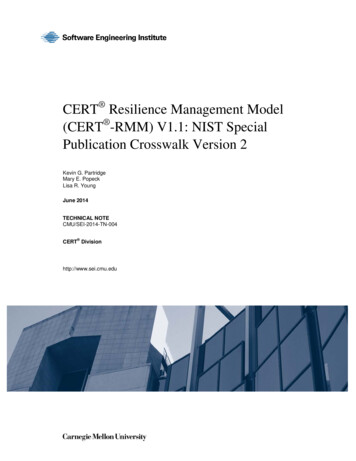
Transcription
CERT Resilience Management Model(CERT -RMM) V1.1: NIST SpecialPublication Crosswalk Version 2Kevin G. PartridgeMary E. PopeckLisa R. YoungJune 2014TECHNICAL NOTECMU/SEI-2014-TN-004 CERT Divisionhttp://www.sei.cmu.edu
Copyright 2014 Carnegie Mellon UniversityThis material is based upon work funded and supported under Contract No. FA8721-05-C-0003 with Carnegie MellonUniversity for the operation of the Software Engineering Institute, a federally funded research and development center sponsoredby the United States Department of Defense.Any opinions, findings and conclusions or recommendations expressed in this material are those of the author(s) and do notnecessarily reflect the views of the United States Department of Defense.This report was prepared for theSEI Administrative AgentAFLCMC/PZM20 Schilling Circle, Bldg 1305, 3rd floorHanscom AFB, MA 01731-2125NO WARRANTY. THIS CARNEGIE MELLON UNIVERSITY AND SOFTWARE ENGINEERING INSTITUTEMATERIAL IS FURNISHED ON AN “AS-IS” BASIS. CARNEGIE MELLON UNIVERSITY MAKES NO WARRANTIESOF ANY KIND, EITHER EXPRESSED OR IMPLIED, AS TO ANY MATTER INCLUDING, BUT NOT LIMITED TO,WARRANTY OF FITNESS FOR PURPOSE OR MERCHANTABILITY, EXCLUSIVITY, OR RESULTS OBTAINEDFROM USE OF THE MATERIAL. CARNEGIE MELLON UNIVERSITY DOES NOT MAKE ANY WARRANTY OF ANYKIND WITH RESPECT TO FREEDOM FROM PATENT, TRADEMARK, OR COPYRIGHT INFRINGEMENT.This material has been approved for public release and unlimited distribution except as restricted below.Internal use:* Permission to reproduce this material and to prepare derivative works from this material for internal use is granted,provided the copyright and “No Warranty” statements are included with all reproductions and derivative works.External use:* This material may be reproduced in its entirety, without modification, and freely distributed in written orelectronic form without requesting formal permission. Permission is required for any other external and/or commercial use.Requests for permission should be directed to the Software Engineering Institute at permission@sei.cmu.edu.* These restrictions do not apply to U.S. government entities.Carnegie Mellon , CERT , CERT Coordination Center and OCTAVE are registered marks of Carnegie Mellon University.DM-0001302
Table of ContentsAbstractiii1Introduction1.1 CERT-RMM Description, Features, and Benefits1.2 CERT-RMM Structure in Relation to NIST Guidelines1222NIST Publications2.1 NIST SP 800-18 Rev. 12.2 NIST SP 800-30 Rev. 12.3 NIST SP 800-34 Rev. 12.4 NIST SP 800-37 Rev. 12.5 NIST SP 800-392.6 NIST SP 800-53 Rev. 42.7 NIST SP 800-53A Rev. 12.8 NIST SP 800-55 Rev. 12.9 NIST SP 800-60 Rev. 12.10 NIST SP 800-61 Rev. 22.11 NIST SP 800-70 Rev. 22.12 NIST SP 800-13744444555556663CERT-RMM Crosswalk of NIST 800-Series Special PublicationsADM – Asset Definition and ManagementAM – Access ManagementCOMM – CommunicationsCOMP – ComplianceCTRL – Controls ManagementEC – Environmental ControlEF – Enterprise FocusEXD – External DependenciesFRM – Financial Resource ManagementHRM – Human Resource ManagementID – Identity ManagementIMC – Incident Management and ControlKIM – Knowledge and Information ManagementMA – Measurement and AnalysisMON – MonitoringOPD – Organizational Process DefinitionOPF – Organizational Process FocusOTA – Organizational Training and AwarenessPM – People ManagementRISK – Risk ManagementRRD – Resilience Requirements DevelopmentRRM – Resilience Requirements ManagementRTSE – Resilient Technical Solution ManagementSC – Service ContinuityTM – Technology ManagementVAR – Vulnerability Analysis and 151516171718191921CMU/SEI-2014-TN-004 i
CMU/SEI-2014-TN-004 ii
AbstractThe CERT Resilience Management Model (CERT -RMM) allows organizations to determinehow their current practices support their desired levels of process maturity and improvement. Thistechnical note maps CERT-RMM process areas to certain National Institute of Standards andTechnology (NIST) special publications in the 800 series. It aligns the tactical practices suggestedin the NIST publications to the process areas that describe management of operational resilienceat a process level. This technical note is an extension of the CERT-RMM Code of PracticeCrosswalk, Commercial Version (CMU/SEI-2011-TN-012) and an update to the CERT Resilience Management Model (CERT -RMM) V1.1: NIST Special Publication CrosswalkVersion 1 (CMU/SEI-2011-TN-028).CMU/SEI-2014-TN-004 iii
CMU/SEI-2014-TN-004 iv
1 IntroductionOrganizations can use the CERT Resilience Management Model (CERT -RMM) V1.1 todetermine how their current practices support their desired level of process maturity in thedomains of security planning and management, business continuity and disaster recovery, and IToperations and service delivery. This technical note supplements and is a follow-on to the CERTResilience Management Model (RMM) v1.1: Code of Practice Crosswalk Commercial Version 1.1[Partridge 2011a]. This follow-on crosswalk connects CERT-RMM process areas to a focused setof National Institute of Standards and Technology (NIST) special publications in the 800 series.Additionally, this technical note updates CERT Resilience Management Model (CERT -RMM)V1.1: NIST Special Publication Crosswalk Version 1 [Partridge 2011b] with new mappings to theCERT-RMM based on the latest versions of NIST SP 800-30, NIST SP 800-53, NIST SP 800-61,and NIST SP 800-137.This document helps to achieve a primary goal of CERT-RMM, which is to allow its adopters tocontinue to use preferred standards and codes of practice at a tactical level while maturingmanagement and improvement of operational resilience at a process level. This document provides a reference for adopters of the model to determine how their current deployment of practicessupports their desired level of process maturity and improvement.The CERT-RMM process areas and the guidance within these NIST special publications arealigned only by subject matter. The materials often conflict, both in their level of detail andintended usage. Many of the NIST documents are very specific and provide direct operationalguidance. These special publications are more prescriptive than the associated CERT-RMMspecific practices. Where this is the case, this crosswalk aligns them according to their sharedsubject matter.Some of the NIST special publications detail process requirements. These much more closely anddirectly align with CERT-RMM goals and practices. In this case the alignment is obvious. ANIST special publication may not completely cover the goals or specific practices within aprocess area, but it may provide a component or subset of the related requirements at the goal orpractice level. The crosswalk does not reflect the discontinuities at this level. It shows only theaffinity between certain NIST 800-series special publications and CERT-RMM goals andpractices according to their shared subject matter and focus.This technical note shows the areas of overlap and redundancy between CERT-RMM processareas and the guidance in the NIST special publications; it also shows the gaps that may affect thematurity of a practice. The CERT-RMM provides a reference model that allows organizations tomake sense of their practices in a process context and improve processes and effectiveness. Thiscrosswalk can help organizations align NIST practices to CERT-RMM process improvementgoals. CERT is a registered mark owned by Carnegie Mellon University.CMU/SEI-2014-TN-004 1
1.1CERT-RMM Description, Features, and BenefitsCERT-RMM V1.1 is a capability maturity model for managing operational resilience. It has twoprimary objectives: Establish the convergence of operational risk and resilience management activities (securityplanning and management, business continuity, IT operations, and service delivery) into asingle model. Apply a process improvement approach to operational resilience management by defining andapplying a capability scale expressed in increasing levels of process maturity.CERT-RMM has the following features and benefits: defines processes, expressed in 26 process areas across four categories: enterprisemanagement, engineering, operations, and process management focuses on the resilience of four essential operational assets: people, information, technology,and facilities includes processes and practices that define a scale of four capability levels for each processarea: incomplete, performed, managed, and defined serves as a meta-model that easily coexists with and references common codes of practice,such as the NIST special publications 800 series, the International Organization for Standards(ISO) and International Electrotechnical Commission (IEC) 27000 series, COBIT, the BritishStandards Institution’s BS 25999, and ISO 24762 includes quantitative process measurements that can be used to ensure operational resilienceprocesses are performing as intended facilitates an objective measurement of capability levels via a structured and repeatableappraisal methodology extends the process improvement and maturity pedigree of Capability Maturity ModelIntegration (CMMI ) to assurance, security, and service continuity activitiesA copy of version 1.0 of CERT-RMM can be obtained at rt-rmm/cert-rmm-model.cfm.1.2CERT-RMM Structure in Relation to NIST GuidelinesCERT-RMM has several key components. The process area forms the major structural element inthe model. Each process area has a series of descriptive components.CERT-RMM refers to two types of practices: specific practices and subpractices. To make use ofthis crosswalk, it is important to understand the distinctions among these types of practices andthe practices contained in common codes of practice.1.2.1Process AreaCERT-RMM comprises 26 process areas. Each process area describes a functional area ofcompetency. In aggregate, these 26 process areas define the operational resilience management CMMI is registered in the U.S. Patent and Trademark Office by Carnegie Mellon University.CMU/SEI-2014-TN-004 2
system. Process areas comprise goals, each achieved through specific practices, which arethemselves broken down into subpractices.GoalsEach process area has a set of goals. Goals are required elements of the process area, and theydefine its target accomplishments. An example of a goal from the Service Continuity process areais “SC:SG1 Prepare for Service Continuity.”Generic goals are defined within individual process areas and pertain to elements that are relevantacross all process areas. Their degree of achievement indicates a process’s level ofinstitutionalization. Achievement of a generic goal is an indicator that the associated practiceshave been implemented across the process area. These goals ensure that the process area will beeffective, repeatable, and lasting.The crosswalk itself could be described as mapping strictly across Generic Goal 1, “AchieveSpecific Goals.” This crosswalk is not intended to map NIST special publication guidelines acrossall generic goals or assert that a special publication helps an organization achieve any particularcapability or maturity rating.Specific PracticesEach process area goal has its own specific practices. Specific practices constitute a process area’sbase practices, reflect its body of knowledge, and express what must be done. An example of aspecific practice from the Service Continuity process area is “SC:SG1.SP1 Plan for ServiceContinuity,” which supports the goal “SC:SG1 Prepare for Service Continuity.”SubpracticesSpecific practices break down into subpractices. Subpractices are informative elements associatedwith each specific practice. These subpractices can often be related to specific process workproducts. Where specific practices focus on what must be done, subpractices focus on how it mustbe done. While not overly prescriptive or detailed, subpractices help the user determine how tosatisfy the specific practices and achieve the goals of the process area. Each organization willhave its own subpractices that it either develops organically or acquires from a code of practice.Subpractices can be linked to the best practices and implementation guidance found in the NIST800-series special publications. Subpractice instructions are usually broad, but many of the specialpublication guidelines can be definitive. For example, a subpractice may suggest that the user “setpassword standards and guidelines,” but a special publication may state that “passwords should bechanged at 90-day intervals.”CMU/SEI-2014-TN-004 3
2 NIST PublicationsThis section details the NIST 800-series special publications that are referenced in this document.The authors of this technical note chose these publications, which focus on IT security, for theirutility within the Federal Information Security Management Act (FISMA) process as it isgenerally interpreted and because the publications cover a broad spectrum of FISMArequirements. Beginning with NIST SP 800-18, the publications provide guidance on securityplan development. Each subsequent publication builds toward more specific guidance andrequirements for a security program. The last three publications cover auxiliary topics impactingthe risk management framework.This section includes information on obtaining copies of each code of practice, which are freelyavailable from the NIST website at http://csrc.nist.gov/publications/PubsSPs.html. NIST and theU.S. Department of Commerce retain all rights to and copyright of the NIST publications.2.1NIST SP 800-18 Rev. 1NIST Special Publication 800-18 Revision 1, Guide for Developing Security Plans for FederalInformation Systems [NIST 2006] describes the development of security requirements and theimplementation of controls based upon those requirements. The standard used in this mapping canbe downloaded 8-Rev1/sp800-18-Rev1-final.pdf.2.2NIST SP 800-30 Rev. 1NIST Special Publication 800-30 Revision 1, Guide for Conducting Risk Assessments [NIST2012a] covers risk calculation and management methodology. It is particularly oriented towardthe management of risk in conjunction with an accreditation program. The standard used in thismapping can be downloaded 0-rev1/sp800 30 r1.pdf.2.3NIST SP 800-34 Rev. 1NIST Special Publication 800-34 Revision 1, Contingency Planning Guide for FederalInformation Systems [NIST 2010a] provides best practices for contingency plan development. It isa recommended guide for federal systems. The guidance provides a baseline of contingency planpractices. It also describes the interrelated, individual contingency plans and their roles in thesystem development lifecycle (SDLC). The publication discusses the integration of variousrequirements, including Federal Information Processing Standards (FIPS) Publication 199 andNIST SP 800-53. The standard used in this mapping can be downloaded 4-rev1/sp800-34-rev1 errata-Nov11-2010.pdf.2.4NIST SP 800-37 Rev. 1NIST Special Publication 800-37 Revision 1, Guide for Applying the Risk ManagementFramework to Federal Information Systems: A Security Life Cycle Approach [NIST 2010b]provides guidance for federal information systems and the application of the Risk ManagementCMU/SEI-2014-TN-004 4
Framework. The standard used in this mapping can be downloaded 7-rev1/sp800-37-rev1-final.pdf.2.5NIST SP 800-39NIST Special Publication 800-39, Managing Information Security Risk: Organization, Mission,and Information System View [NIST 2011a] is the core document for integration of the NISTapproach to risk management into a comprehensive Enterprise Risk Management (ERM)program. Developed in response to FISMA, SP 800-39 provides guidance on developing acomprehensive risk management program that includes all aspects of operations. Other, morefocused NIST special publications support this guidance. The standard used in this mapping canbe downloaded at SP800-39-final.pdf.2.6NIST SP 800-53 Rev. 4NIST Special Publication 800-53 Revision 4, Security and Privacy Controls for FederalInformation Systems and Organizations [NIST 2013] comprises a selection of security andprivacy controls for executive federal agencies. These guidelines are pertinent to all systemcomponents that process federal information. The standard used in this mapping can bedownloaded at x J, Privacy Control Catalog, is a new addition to NIST 800-53. Its privacy controls havebeen mapped to CERT-RMM as a special type of controls for handling and protecting anorganization’s critical information. Though personally identifiable information (PII) is mostcritical to individuals, organizations may suffer legal penalties and harm to their reputation if theydo not properly implement privacy controls. As a result, PII may be thought of as criticalinformation with unique requirements and, if improperly handled, legal ramifications.2.7NIST SP 800-53A Rev. 1NIST Special Publication 800-53A Revision 1, Guide for Assessing the Security Controls inFederal Information Systems and Organizations: Building Effective Security Assessment Plans[NIST 2010c] details a process for assessing the effectiveness and appropriateness of the securitycontrols deployed by a federal organization. The standard used in this mapping can bedownloaded at -rev1/sp800-53A-rev1-final.pdf.2.8NIST SP 800-55 Rev. 1NIST Special Publication 800-55 Revision 1, Performance Measurement Guide for InformationSecurity [NIST 2008a] provides guidance on the development of measures to describe thefunctioning of an organization’s security program, as well as guidance on the subsequentdevelopment of controls. The publication considers various mandates and requirements, includingFISMA. The standard used in this mapping can be downloaded 5-Rev1/SP800-55-rev1.pdf.2.9NIST SP 800-60 Rev. 1NIST Special Publication 800-60 Volume I Revision 1, Guide for Mapping Types of Informationand Information Systems to Security Categories [NIST 2008b] and Volume II, Appendices [NISTCMU/SEI-2014-TN-004 5
2008c] provide guidelines for system owners mapping the sensitivity and criticality of theirsystems according to FISMA requirements. The standards used in this mapping can bedownloaded at rev1/SP800-60 Vol1-Rev1.pdfand rev1/SP800-60 Vol2-Rev1.pdf.2.10 NIST SP 800-61 Rev. 2NIST Standard Publication 800-61 Revision 2, Computer Security Incident Handling Guide[NIST 2012b] provides guidance for the appropriate handling of computer security incidents. Thepublication also contains guidance for implementing a tailored incident handling program. Thestandard used in this mapping can be downloaded ions/NIST.SP.800-61r2.pdf.2.11 NIST SP 800-70 Rev. 2NIST Special Publication 800-70 Revision 2, National Checklist Program for IT Products—Guidelines for Checklist Users and Developers [NIST 2011b] is an index to the NationalChecklist Program’s repository of checklists. It also provides guidance on the associated policiesof the National Checklist Program. The standard used in this mapping can be downloaded 0-rev2/SP800-70-rev2.pdf.2.12 NIST SP 800-137NIST Special Publication 800-137, Information Security Continuous Monitoring (ISCM) forFederal Information Systems and Organizations [NIST 2011c] comprises the NIST guidance fordevelopment and implementation of a continuous monitoring strategy. The guidance broadlyfocuses on awareness of threats and vulnerabilities, as well as the controls deployed against thosevulnerabilities. The publication discusses a continuous strategy that balances risk, awareness, andresponse capability. The standard used in this mapping can be downloaded at /SP800-137-Final.pdf.CMU/SEI-2014-TN-004 6
3 CERT-RMM Crosswalk of NIST 800-Series SpecialPublicationsCERT-RMM V1.1Process Areas, Goals, and Specific PracticesNIST Special PublicationsSP No.800-Section Numbers Related to the NIST Publication(Control Numbers for 800-53 Rev. 4)ADM – Asset Definition and ManagementADM:SG1 Establish Organizational AssetsADM:SG1.SP1 Inventory AssetsADM:SG1.SP2 Establish a CommonUnderstanding37R12.353R4CM-8, PE-8, PE-20, PM-5, RA-2, SA-19, SC-3837R12.3392.6.260V1R1 3.1ADM:SG1.SP3 Establish Ownership andCustodianship18R11.737R12.353AR13.1ADM:SG2 Establish the Relationship Between Assets and ServicesADM:SG2.SP1 Associate Assets with Services37R12.1, 2.353R4PM-11, RA-2, SE-153R4SA-22ADM:SG2.SP2 Analyze Asset-ServiceDependenciesADM:SG3 Manage AssetsADM:SG3.SP1 Identify Change CriteriaADM:SG3.SP2 Maintain Changes to Assets and 53R4InventoryPE-20, SE-1AM – Access ManagementAM:SG1 Manage and Control AccessAM:SG1.SP1 Enable Access53R4AC-1, AC-2, AC-3, AC-5, AC-6, AC-10, AC-12, AC-24, AC-25, AR-3, CM-11,IA-1, IA-2, IA-8, IP-2, MA-3, MA-4, MA-5, MP-2, PE-1, PE-2, PE-3, PE-16,PL-2, PL-4, SA-21, SC-2, SI-11AM:SG1.SP2 Manage Changes to AccessPrivileges53R4AC-2AM:SG1.SP3 Periodically Review and MaintainAccess Privileges53R4AC-2AM:SG1.SP4 Correct Inconsistencies53R4AC-2COMM – CommunicationsCOMM:SG1 Prepare for Resilience CommunicationsCOMM:SG1.SP1 Identify Relevant StakeholdersCOMM:SG1.SP2 Identify CommunicationsRequirementsCOMM:SG1.SP3 Establish CommunicationsGuidelines and Standards53R4IP-3COMM:SG2 Prepare for Communications ManagementCOMM:SG2.SP1 Establish a ResilienceCommunications Plan53AR13.1COMM:SG2.SP2 Establish a ResilienceCommunications Program53R4PM-16, TR-1, TR-2, TR-3COMM:SG2.SP3 Identify and Assign Plan Staff 53AR13.1COMM:SG3 Deliver Resilience CommunicationsCOMM:SG3.SP1 Identify CommunicationsMethods and Channels34R14.2.253R4CA-9, PM-15, SC-37, SI-5CMU/SEI-2014-TN-004 7
CERT-RMM V1.1Process Areas, Goals, and Specific PracticesCOMM:SG3.SP2 Establish and MaintainCommunications InfrastructureNIST Special PublicationsSP No.800-Section Numbers Related to the NIST Publication(Control Numbers for 800-53 Rev. 4)53R4SI-553AR13.1COMP:SG1.SP1 Establish a Compliance Plan53R4CA-1COMP:SG1.SP2 Establish a ComplianceProgram53R4AU-1COMP:SG1.SP3 Establish ComplianceGuidelines and Standards53R4AU-3, AU-5, UL-2COMP:SG2.SP1 Identify ComplianceObligations53R4AP-1, AP-2, AR-1, AU-2, CM-10, DM-3, SI-4COMP:SG2.SP2 Analyze Obligations53R4CM-10COMP:SG2.SP3 Establish Ownership forMeeting Obligations53R4AU-1, DI-2COMM:SG4 Improve CommunicationsCOMM:SG4.SP1 Assess CommunicationsEffectivenessCOMM:SG4.SP2 Improve CommunicationsCOMP – ComplianceCOMP:SG1 Prepare for Compliance ManagementCOMP:SG2 Establish Compliance ObligationsCOMP:SG3 Demonstrate Satisfaction of Compliance ObligationsCOMP:SG3.SP1 Collect and ValidateCompliance Data53R4AR-4, AR-8, AU-3, AU-6, AU-11, AU-16, CM-10, IP-2, UL-1, UL-2COMP:SG3.SP2 Demonstrate the Extent ofCompliance Obligation Satisfaction53R4AR-6, AU-7, AU-11, CM-11COMP:SG3.SP3 Remediate Areas of NonCompliance53R4AR-434R13.437R12.4COMP:SG4 Monitor Compliance ActivitiesCOMP:SG4.SP1 Evaluate Compliance ActivitiesCTRL – Controls ManagementCTRL:SG1 Establish Control ObjectivesCTRL:SG1.SP1 Define Control Objectives53AR13.1, 3.2.11372.1, 3.1.334R13.4CTRL:SG2 Establish ControlsCTRL:SG2.SP1 Define Controls37R12.4, Task 2-1, Task 2-253R4AU-15, PM-7, SA-151372.1.2CTRL: SG3 Analyze ControlsCTRL:SG3.SP1 Analyze Controls37R1Task 2-1, Task 2-3, Task 3-1, App. G53AR13.2.1, 3.2.21372.1.2, 2.1.3, 3.1.2, 3.2.1, 3.2.2, 3.3, 3.4.1, 3.4.2, 3.5, 3.637R1Task 4-1, Task 4-2, Task 4-3, Task 4-4, Task 6-2, Task 6-3CTRL:SG4 Assess Control EffectivenessCTRL:SG4.SP1 Assess Controls53AR13.31372.1.3, 2.2, 3.1.2, 3.1.3, 3.2.2, 3.3, 3.4.2, 3.5, 3.6CMU/SEI-2014-TN-004 8
CERT-RMM V1.1Process Areas, Goals, and Specific PracticesNIST Special PublicationsSP No.800-Section Numbers Related to the NIST Publication(Control Numbers for 800-53 Rev. 4)EC – Environmental ControlEC:SG1 Establish and Prioritize Facility AssetsEC:SG1.SP1 Prioritize Facility AssetsEC:SG1.SP2 Establish Resilience-FocusedFacility Assets34R13.4.353R4SC-44EC:SG2 Protect Facility AssetsEC:SG2.SP1 Assign Resilience Requirementsto Facility Assets34R13.4.353R4PE-3, PE-4, PE-6, PE-9, PE-13, PE-17, PE-1853AR13.170R23EC:SG2.SP2 Establish and Implement Controls 34R13.4.353R4CP-12, CP-13, PE-2, PE-3, PE-8, PE-16, SC-4053AR13.1EC:SG3 Manage Facility Asset RiskEC:SG3.SP1 Identify and Assess Facility Asset 53R4RiskPM-7EC:SG3.SP2 Mitigate Facility RisksPM-4, PM-7, SA-22, SC-36, SC-37, SC-3853R4EC:SG4 Control Operational EnvironmentEC:SG4.SP1 Perform Facility SustainabilityPlanning34R13.253R4CP-6, CP-7, PE-10, PE-11, PE-12, PE-13, PE-14, PE-15, PM-1160V1R1 3.2, 4.6EC:SG4.SP2 Maintain EnvironmentalConditions53R4PE-10, PE-11, PE-12, PE-13, PE-14, PE-1553R4CP-853R4AP-2, PM-7EC:SG4.SP3 Manage Dependencies on PublicServicesEC:SG4.SP4 Manage Dependencies on PublicInfrastructureEC:SG4.SP5 Plan for Facility RetirementEF – Enterprise FocusEF:SG1 Establish Strategic ObjectivesEF:SG1.SP1 Establish Strategic Objectives53AR13.155R15.2EF:SG1.SP2 Establish Critical Success Factors 34R153R43.2.1IP-1, PM-753AR13.155R11.453R4PM-7, PM-1155R15.5.2EF:SG2.SP1 Establish an OperationalResilience Management Plan53R4AR-1, IP-2, PL-2, PL-7, PL-8, PM-1, PM-4, PM-8EF:SG2.SP2 Establish an OperationalResilience Management Program53R4AR-1, IP-2, PL-9, PM-1, PM-4, PM-1353R4PM-3EF:SG1.SP3 Establish Organizational ServicesEF:SG2 Plan for Operational ResilienceEF:SG3 Establish SponsorshipEF:SG3.SP1 Commit Funding for OperationalResilience ManagementEF:SG3.SP2 Promote a Resilience-AwareCultureEF:SG3.SP3 Sponsor Resilience Standards and 53R4Policies53AR1PL-13.1CMU/SEI-2014-TN-004 9
CERT-RMM V1.1Process Areas, Goals, and Specific PracticesNIST Special PublicationsSP No.800-Section Numbers Related to the NIST Publication(Control Numbers for 800-53 Rev. 4)EF:SG4 Provide Resilience OversightEF:SG4.SP1 Establish Resilience as aGovernance Focus Area53R4CA-6, PL-1EF:SG4.SP2 Perform Resilience Oversight53R4PM-6EF:SG4.SP3 Establish Corrective Actions55R16.3EXD – External DependenciesEXD:SG1 Identify and Prioritize External DependenciesEXD:SG1.SP1 Identify External Dependencies53R4PL-8EXD:SG1.SP2 Prioritize External DependenciesEXD:SG2 Manage Risks Due to External DependenciesEXD:SG2.SP1 Identify and Assess Risks Due toExternal DependenciesEXD:SG2.SP2 Mitigate Risks Due to ExternalDependencies53R4SA-21, SC-38EXD:SG3.SP1 Establish EnterpriseSpecifications for External Dependencies53R4AC-20, AR-3, SA-2, SA-12, UL-2EXD:SG3.SP2 Establish ResilienceSpecifications for External Dependencies53R4SA-12, SA-13EXD:SG3.SP3 Evaluate and Select ExternalEntities53R4SA-2, SA-3, SA-12EXD:SG3.SP4 Formalize Relationships53R4AU-16, CA-3, DI-2, SA-3, SA-4, SA-9, SA-11, SA-12, SA-13EXD:SG4.SP1 Monitor External EntityPerformance53R4AR-4, SA-3, SA-9, SA-12, SA-13EXD:SG4.SP2 Correct External EntityPerformance53R4SA-3, SA-1234R13.4.534R13.4.5EXD:SG3 Establish Formal RelationshipsEXD:SG4 Manage External Entity PerformanceFRM – Financial Resource ManagementFRM:SG1 Establish Financial CommitmentFRM:SG1.SP1 Commit Funding for OperationalResilience ManagementFRM:SG1.SP2 Establish Structure to SupportFinancial ManagementFRM:SG2 Perform Financial PlanningFRM:SG2.SP1 Define Funding NeedsFRM:SG2.SP2 Establish Resilience BudgetsFRM:SG2.SP3 Resolve Funding GapsFRM:SG3 Fund Resilience ActivitiesFRM:SG3.SP1 Fund Resilience ActivitiesFRM:SG4 Account for Resilience ActivitiesFRM:SG4.SP1 Track and Document CostsFRM:SG4.SP2 Perform Cost and PerformanceAnalysisFRM:SG5 Optimize Resilience Expenditures and InvestmentsFRM:SG5.SP1 Optimize ResilienceExpendituresFRM:SG5.SP2 Determine Return on ResilienceInvestmentsFRM:SG5.SP3 Identify Cost RecoveryOpportunitiesCMU/SEI-2014-TN-004 10
CERT-RMM V1.1Process Areas, Goals, and Specific PracticesNIST Special PublicationsSP No.800-Section Numbers Related to the NIST Publication(Control Numbers for 800-53 Rev. 4)HRM – Human Resource ManagementHRM:SG1 Establish Resource NeedsHRM:SG1.SP1 Establish BaselineCompetencies53AR13.1HRM:SG1.SP2 Inventory Skills and IdentifyGapsHRM:SG1.SP3 Address Skill DeficienciesHRM:SG2 Manage Staff AcquisitionHRM:SG2.SP1 Verify Suitability of CandidateStaff53R4PE-253AR13.153AR13.1ID:SG1.SP1 Create Identities53R4AC-5, AC-6, IA-2, IA-4, IA-9, PE-2ID:SG1.SP2 Establish Identity Community53R4AC-5, AC-6, AC-22, IA-2, IA-4, PE-2ID:SG1.SP3 Assign Roles to Identities53R4AC-5, AC-6, IA-1, IA-2, IA-4, PE-2ID:SG2.SP1 Monitor and Manage IdentityChanges53R4AC-2, IA-11ID:SG2.SP2 Periodically Review and MaintainIdentities53R4AC-2, IA-11ID:SG2.SP3 Correct Inconsistencies53R4AC-2ID:SG2.SP4 Deprovision Identities53R4AC-2HRM:SG2.SP2 Establish Terms and Conditionsof EmploymentHRM:SG3 Manage Staff PerformanceHRM:SG3.SP1 Establish Resilience as a JobResponsibilityHRM:SG3.SP2 Establish ResiliencePerformance Goals and ObjectivesHRM:SG3.SP3 Measure and AssessPerformanceHRM:SG3.SP4 Establish Disciplinary ProcessHRM:SG4 Manage Changes to Employment StatusHRM:SG4.SP1 Manage Impact of PositionChangesHRM:SG4.SP2 Manage Access to AssetsHRM:SG4.SP3 Manage InvoluntaryTerminationsID – Identity ManagementID:SG1 Establish IdentitiesID:SG2 Manage IdentitiesIMC – Incident Management and ControlIMC:SG1 Establish the Incident Management and Control ProcessIMC:SG1.SP1 Plan for Incident ManagementIMC:SG1.SP2 Assign Staff to the IncidentManagement Plan53R4AC-14, IR-4, IR-8, PM-12, SA-15, SE-261R22, 2.3, 2.3.253R4IR-4, IR-8, IR-1061R22.4, 2.4.2, 2.4.3, 2.4.4, 2.6IMC:SG2 Detect EventsIMC:SG2.SP1 Detect and Report EventsIMC:SG2.SP2 Log and Track Event
1.1 CERT-RMM Description, Features, and Benefits 2 1.2 CERT-RMM Structure in Relation to NIST Guidelines 2 2 NIST Publications 4 2.1 NIST SP 800-18 Rev. 1 4 2.2 NIST SP 800-30 Rev. 1 4 2.3 NIST SP 800-34 Rev. 1 4 2.4 NIST SP 800-37 Rev. 1 4 2.5 NIST SP 800-39 5 2.6 NIST SP 800-53 Rev. 4 5 2.7 NIST SP 800-53A Rev. 1 5
